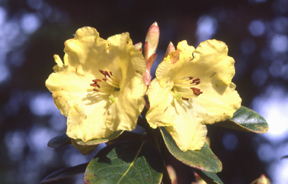
Of all the brilliantly colored flowers in nature’s vast repertoire, I have a special affinity for those of the yellow persuasion. Now by yellow I mean the deep solid yellow found in many species of Narcissus (daffodils), for example, or the pure yellow of a buttercup. This fondness, in combination with an unreasonable lust for dwarf shrubs (the small size of my home garden has a little to do with this I think), provides me with more than enough incentive to covet and cherish a fine selection of dwarf Rhododendron species including megeratum, sargentianum, monanthum, hanceanum ‘Rowallane’ luteiflorum, chrysodoron (the last two are not exactly “dwarf” but close enough), ludlowii, lowndesii, anthopogon ssp. hypenanthum, valentinianum, rupicola var. chryseum, and the subject of this discourse, R. sulfureum.
R. sulfureum (“sulfur-colored”) was first found by western plant hunters in 1886 when it was collected by the French Missionary Abbe Delavay in the Cangshan, a famous range of mountains located in northern Yunnan, China. In 1910, while botanizing in the same range of mountains, George Forrest also located and collected R. sulfureum and introduced it as seed into cultivation (F#6777). Since that time, this species has been collected many times from a wide variety of habitats, but it is generally found in fairly open positions with extremely sharp drainage such as cliffs and boulders or even as an epiphyte. It occurs at elevations of 7,000 to 13,000 feet from W Yunnan to N Burma and SE Tibet.
R. sulfureum is a member of subsection Boothia, one of the smaller and less widely known lepidote (scale-bearing) groups. The members of this subsection are small, often epiphytic shrubs sharing similar morphological features, and many, coming from relatively low altitudes, are generally grown outdoors only in milder regions. Other cultivated species within this subsection are boothii, dekatanum, leptocarpum, leucaspis, megeratum, and chrysodoron. R. sulfureum itself is quite a variable species, ranging in habit from low, almost prostrate forms to upright-growing forms three or four feet in height, up to six feet in the wild. The foliage is also incredibly variable, from one to four inches in length and up to two inches wide, ranging in shape from elliptic to ovate, obovate, and oblong. The upper surface is shiny dark green with hairs on the leaf margin and a typically glaucous and densely scaly lower surface. In early to mid-spring the flowers appear in clusters of three to eight per inflorescence. The brightly-colored blossoms are bell-shaped with flared lobes and generally about one inch in length. They range in color from greenish yellow to deep or bright yellow.
The tremendous variation within R. sulfureum is quite evident when you take note of its numerous synonyms. In his 1980 revision of subgenus Rhododendron, Dr. James Cullen reduced (“lumped”) three closely related species (cerinum, commodum, and theiochroum) into synonymy with R. sulfureum. These “species” were separated by minor characteristics and represented natural variations within a single fairly widespread species. I was able to observe this variation first-hand during an expedition to W Yunnan in the fall of 1997. During a particularly rainy day of botanizing in the Biluoxue Shan along the Yunnan/Burma frontier, we collected several different specimens of what seemed to be two or three different lepidote species but which none of us could identify with any assurance. One of these specimens was collected from a six-foot upright-growing shrub with four-inch long leaves and big round buds. My first impression of this specimen was R. chrysodoron, as it looked very similar to the clone of that species which is grown at the RSBG. After keying them out that evening back in the hotel we came to the conclusion that they were all R. sulfureum! An outstanding example of natural variation within a species, even at the local level.
Although seldom seen outside of rhododendron collections, R. sulfureum can be a fine addition to the rhododendron or woodland garden. It is an attractive dwarf species, deserving of wider attention, with brilliant yellow flowers, smooth and glossy, exfoliating deep brown bark, and dark, shiny green foliage. In cultivation, R. sulfureum prefers a fairly open location with excellent drainage although it does quite well in a woodland setting provided the shade is not too deep. It is rated by Peter Cox as being hardy to temperatures as low as +5 or even 0°F. depending on the clone. This species is grown outside at the RSBG and blooms for us quite early in the spring. It was killed in 1990 when we recorded 4°F. in November. R. sulfureum has been little used as a parent in hybridizing programs, if at all. A clone with sulfur yellow flowers received the Award of Merit when shown by the Earl of Stair as R. commodum in 1937.
ACCESSIONS IN THE COLLECTION OF THE RSF:
2000/079 CCHH#8236
2000/089 CCHH#8236
2000/101 CCHH#8236
2000/106 CCHH#8236
2000/113 CCHH#8236
2000/119 CCHH#8236
2000/122 CCHH#8236 All from my collection of seed at 11,000 ft.
2002/040 CCHH#8052
2002/066 CCHH#8052
2002/070 CCHH#8052
2002/095 CCHH#8052
2002/111 CCHH#8052
2005/102 CCHH#8052 All from my collection of seed at 8,850 ft.
NOTE: 1974/108 sulfureum “round-leaf” from Glendoick was sold as such for many years. This clone has been moved into the closely related species dekatanum.
REFERENCES:
Cox, Peter A. and Kenneth N. E. Cox. 1997. The Encyclopedia of Rhododendron Species. Perth, Scotland: Glendoick Press. Pgs. 235-239.
Cullen, J. 1980. A Revision of Rhododendron. I. Subgenus Rhododendron sections Rhododendron & Pogonanthum. Notes from the Royal Botanic Garden Edinburgh. Vol. 39(1): pgs. 133-138.
Davidian, H. H. 1982. The Rhododendron Species. Vol. I. Portland, OR: Timber Press. Pgs. 73-74.
Hootman, S. E. Unpublished field notes – 1997 to present.
Rhododendron Species Foundation: Records – 1964 to present.
Steve Hootman
